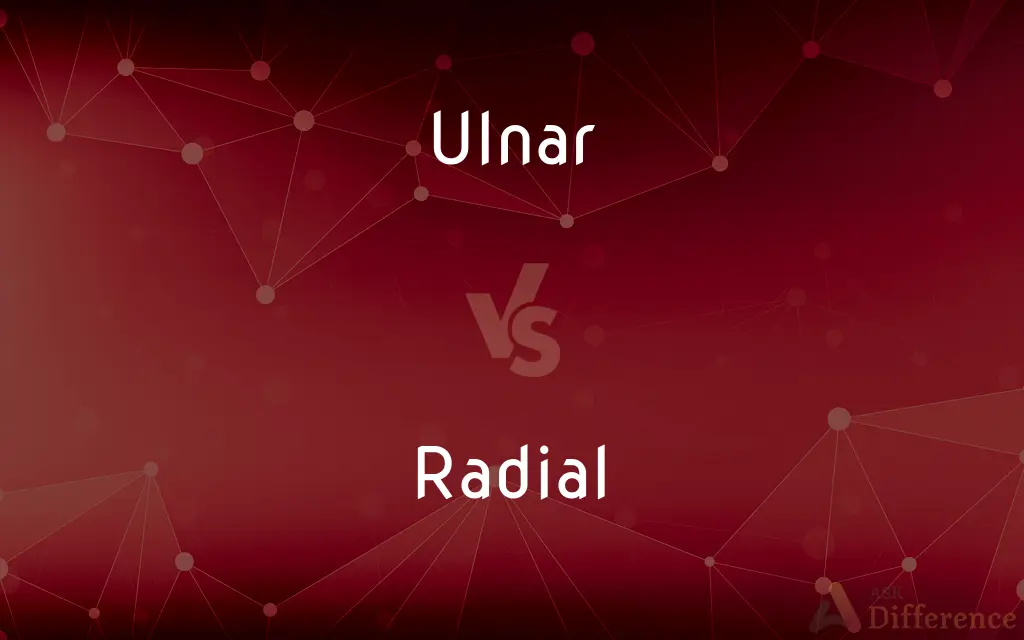Ulnar vs. Radial — What's the Difference?
By Maham Liaqat & Urooj Arif — Updated on March 26, 2024
Ulnar pertains to the ulna, the bone on the pinkie side of the forearm, crucial for arm movement and stability, while radial refers to the radius, the bone on the thumb side, essential for wrist rotation.

Difference Between Ulnar and Radial
Table of Contents
ADVERTISEMENT
Key Differences
The ulna, associated with the term "ulnar," is one of the two long bones in the forearm, located on the side closest to the body's midline and the pinkie finger. This positioning allows it to play a vital role in the arm's stability and in forming the elbow joint. On the other hand, the radius, or "radial," is the other long bone in the forearm, situated on the side closer to the thumb. It is key in controlling wrist movements, especially pronation and supination, which involve rotating the wrist to turn the palm down or up, respectively.
Ulnar actions are crucial in movements that require a strong grip or stabilization of the arm, as the ulna serves as a primary attachment point for several muscles involved in these functions. Whereas, radial actions are more associated with the precise manipulation of objects, thanks to the radius's pivotal role in wrist and hand movement.
In terms of injuries, ulnar-related issues often involve the ulnar nerve, which can lead to conditions like cubital tunnel syndrome, affecting sensation in the ring and pinkie fingers. Radial injuries, however, frequently involve fractures of the radius bone, significantly impacting wrist motion and forearm rotation.
Medical treatments and interventions also differ; ulnar problems may require procedures to relieve nerve compression or repair fractures near the elbow, while radial issues might necessitate surgery to restore wrist function or realign the radius for proper healing.
From a physiological standpoint, the ulnar side of the hand and wrist is generally less involved in fine motor skills than the radial side. This is because the radial side, with its greater range of motion, facilitates intricate movements like writing or typing.
ADVERTISEMENT
Comparison Chart
Location in Forearm
Closer to pinkie finger and body's midline
Closer to thumb and outer side of forearm
Main Function
Arm stability and forming elbow joint
Wrist rotation and hand manipulation
Common Injuries
Ulnar nerve entrapment, fractures near the elbow
Radius bone fractures, wrist injuries
Medical Treatment
Nerve decompression, elbow fracture repair
Wrist function surgery, bone realignment
Role in Movement
Grip strength and arm stabilization
Precision manipulation, fine motor skills
Compare with Definitions
Ulnar
Relating to the ulna, the inner and longer of the two bones of the human forearm.
The ulnar side of her arm was bruised after the fall.
Radial
Relating to the lateral aspect of the forearm or hand.
Radial pulse can be felt at the wrist's thumb side.
Ulnar
Involving the ulnar nerve, which runs near the ulna.
Ulnar nerve compression can cause numbness in the hand.
Radial
Pertaining to the radius, the shorter of the two forearm bones, lying parallel to the ulna.
The radial fracture required immediate attention.
Ulnar
Pertaining to the side of the forearm or hand closest to the body's midline.
Ulnar deviation involves moving the wrist towards the pinkie finger.
Radial
Descriptive of procedures or treatments targeting the radius or related structures.
Radial head replacement is a common procedure after severe fractures.
Ulnar
Associated with movements or conditions affecting the ulna.
The pitcher's ulnar ligament was strained during the game.
Radial
Involving the radial nerve, which affects the back of the hand and thumb.
Radial nerve palsy results in difficulty lifting the wrist.
Ulnar
Descriptive of procedures or treatments targeting the ulna or related structures.
The surgeon performed an ulnar shortening osteotomy.
Radial
Associated with movements or conditions affecting the radius.
Her radial deviation is limited due to arthritis.
Ulnar
The bone extending from the elbow to the wrist on the side opposite to the thumb in humans.
Radial
Of or arranged like rays or the radii of a circle; diverging in lines from a common centre
Four mosaics have a radial arrangement
Ulnar
A corresponding bone in the forelimb of other vertebrates.
Radial
Relating to the radius.
Ulnar
Of or pertaining to the ulna, or the elbow
Radial
A radial tyre.
Ulnar
Of or pertaining to the ulna, or the elbow; as, the ulnar nerve.
Radial
A radial road.
Ulnar
Relating to or near the ulna
Radial
A supporting ray in a fish's fin.
Radial
A radial engine.
Radial
Of, relating to, or arranged like rays or radii.
Radial
Radiating from or converging to a common center.
Radial
Having or characterized by parts so arranged or so radiating.
Radial
Moving or directed along a radius.
Radial
(Anatomy) Of, relating to, or near the radius or forearm.
Radial
Developing symmetrically about a central point.
Radial
A radial part, such as a ray, spoke, or radius.
Radial
A radial tire.
Radial
Arranged like rays that radiate from, or converge to a common centre.
Radial
Moving along a radius.
Radial
(anatomy) Of, or relating to the radius bone.
Radial
(entomology) Of, or relating to the radius vein, and/or the wing areas next to it.
Radial
(botany) Developing uniformly on all sides.
Radial
A radial tire / radial tyre.
Radial
Of or pertaining to a radius or ray; consisting of, or like, radii or rays; radiated; as, (Bot.) radial projections; (Zool.) radial vessels or canals; (Anat.) the radial artery.
Radial
Pneumatic tire that has radial-ply casing
Radial
Relating to or near the radius;
The radial aspect of the forearm
Radial
Relating to or moving along or having the direction of a radius;
Radial velocity
Radial
Issuing in rays from a common centerXs; relating to rays of light;
Radial heat
Radial
Arranged like rays or radii; radiating from a common center;
Radial symmetry
A starlike or stellate arrangement of petals
Many cities show a radial pattern of main highways
Common Curiosities
What is radial deviation?
Radial deviation is the movement of bending the wrist towards the thumb side.
What does radial mean in anatomy?
In anatomy, radial refers to anything pertaining to the radius, including its position, related movements, or conditions.
What causes ulnar wrist pain?
Ulnar wrist pain can result from injuries, nerve compression, or conditions like arthritis affecting the ulna's side of the wrist.
What function does the radial bone serve?
The radial bone facilitates wrist rotation and contributes to hand manipulation and grip.
Why is the ulna important?
The ulna is important for arm stability, forming the elbow joint, and serving as an attachment point for muscles.
Can you break your ulnar bone?
Yes, it's possible to break the ulnar bone, typically through direct impact or stress.
What activities can exacerbate radial pain?
Activities involving repetitive wrist motions or pressure on the thumb side can exacerbate radial pain.
What is the ulnar side of the hand?
The ulnar side of the hand is the edge closest to the pinkie finger and the body's midline.
Is the radius bone larger than the ulna?
The radius is shorter but wider near the wrist than the ulna, making it appear larger in that area.
How do ulnar and radial nerves differ?
The ulnar nerve runs along the ulna and affects the ring and pinkie fingers, while the radial nerve follows the radius, impacting the back of the hand and thumb.
How are ulnar injuries treated?
Ulnar injuries are treated with a combination of rest, physical therapy, and sometimes surgery, depending on the severity.
Can radial nerve damage be repaired?
Radial nerve damage can often be repaired or improve over time with medical intervention and physical therapy.
Does the ulna connect to the wrist?
Yes, the ulna connects to the wrist and is integral to its structure and function, albeit indirectly through the ulnar side of the wrist.
What symptoms indicate a radial fracture?
Symptoms of a radial fracture include severe wrist pain, swelling, and difficulty moving the hand or wrist.
How do you test for ulnar nerve damage?
Testing for ulnar nerve damage involves clinical evaluations, nerve conduction studies, and sometimes imaging tests.
Share Your Discovery

Previous Comparison
Palpation vs. Percussion
Next Comparison
Persue vs. PersuitAuthor Spotlight
Written by
Maham LiaqatCo-written by
Urooj ArifUrooj is a skilled content writer at Ask Difference, known for her exceptional ability to simplify complex topics into engaging and informative content. With a passion for research and a flair for clear, concise writing, she consistently delivers articles that resonate with our diverse audience.
















































